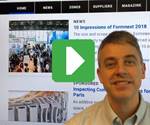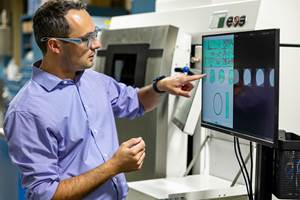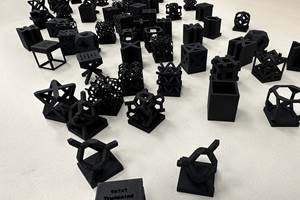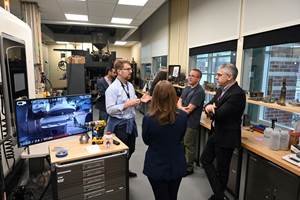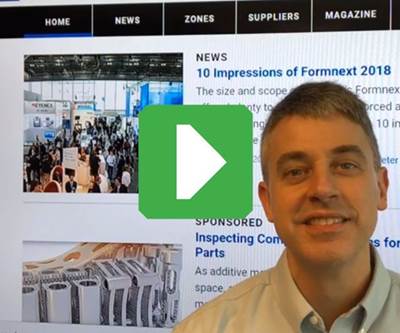Top 10 Stories of 2018
Additive manufacturing's advance into production, metal 3D printing and machine learning top the list of this year's most-read stories.
Each year, the editors of Additive Manufacturing look back at the page view analytics for the past year to determine which online stories were the most popular among readers. Some years, this list is wide-ranging and varied. In other years, it is a microcosm of clear industry trends.
The 2018 list is of the latter variety. Our top stories lean heavily toward metal 3D printing, and metal 3D printing of end-use parts, at that. However, tooling applications and polymer printing are also represented. But perhaps most telling is the story that tops our list, a feature article that dives deep into the promise of machine learning for AM. The story of additive’s advance is increasingly one that unfolds alongside other emerging technologies. We expect to see more interplay between AM and machine learning, AI, automation and other advances like this in 2019.
-
How Machine Learning Is Moving AM Beyond Trial and Error
The characteristics of a metal 3D-printed part produced in a powder bed process are potentially affected by laser power, laser speed, laser spot size, pass overlap, composition of the powder, melt point...and numerous other variables. And that’s just for one AM method. Our top story for 2018 explores why AM’s variables make it ripe to benefit from machine learning and artificial intelligence. -
Postprocessing Steps and Costs for Metal 3D Printing
This is the second year in a row that an article about postprocessing has occupied the number 2 slot in this list. AM users have largely accepted that a 3D-printed part is also likely to be a heat-treated, machined or otherwise finished part. Contributor Dr. Timothy Simpson offers tips for processing metal parts after they come out of the printer. -
10 Impressions of Formnext 2018
The 2018 edition of Formnext was remarkable for its size and variety, but most of all for how it showcased AM’s maturity. Subtle gains in technology, changing roles for material suppliers and enterprise-level software were among the trends our editors spotted at the show; find the whole list at the link above. -
Roush Uses Engine Cylinder Head to Prove Out Additive Manufacturing
Roush was in the process of commissioning a new metal AM machine when the idea came to 3D print and test some critically stressed parts. Just by chance, the team had been working on a cylinder head at the time and decided to see how a 3D-printed version of this part would perform. They share their results in this story. -
Printing Solid, Simple Metal Parts in Minutes, Spee3D Process Is Competition for Casting
Spee3D has developed a “supersonic 3D deposition” strategy to build metal parts. But the company doesn’t see other metal 3D printing processes as its competition. Company co-founder and CEO Byron Kennedy explains how and why Spee3D is instead competing against casting. -
5 Lessons About Additive Manufacturing We Can Learn from This Part
A 3D-printed titanium bracket is more than just a functional part; this workpiece illustrates some fundamental points about additive manufacturing, topology optimization, materials, postprocessing and more. -
3D-Printed Parts Said to Outperform 17-4 PH Stainless Steel
How do 3D-printed parts match up to conventionally manufactured materials? In this case study, ITAMCO compares 3D-printed parts made with EOS 17-4 PH IndustryLine metal powder with heat-treated 17-H stainless steel. -
3D-Printed Sneakers Gaining Traction
3D printing is gaining ground in the consumer market, particularly in footwear. Contributor Heather Caliendo breaks down the major players in 3D-printed sneakers and the various ways they are pursuing additive manufacturing. -
In Additive’s Evolution, Aerospace Proves the Fittest
“Hype” is still an issue in additive manufacturing today, but there is one industrial sector that has produced AM success stories for years: aerospace. Incodema3D details its strategy for meeting the demands of this exacting industry with 3D printing expertise and vertical integration with sister companies. -
3D-Printed Tooling Offers Durability for Precast Concrete
3D printing is changing how tooling is made in a range of industries, including concrete. Gate Precast shares its experience using carbon fiber-filled ABS forms made on large-scale 3D printers to manufacture more than 900 concrete windows for a NYC building.
For more additive manufacturing content, subscribe to our e-newsletter and magazine.
Related Content
Inspection Method to Increase Confidence in Laser Powder Bed Fusion
Researchers developed a machine learning framework for identifying flaws in 3D printed products using sensor data gathered simultaneously with production, saving time and money while maintaining comparable accuracy to traditional post-inspection. The approach, developed in partnership with aerospace and defense company RTX, utilizes a machine learning algorithm trained on CT scans to identify flaws in printed products.
Read MoreHexagon Invests in Divergent’s Autonomous, Sustainable Manufacturing
The Divergent Adaptive Production System (DAPS) is a fully integrated software and hardware solution, creating a complete modular digital factory that combines AI-optimized generative design software, additive manufacturing and automated assembly to build lightweight automotive parts and frames.
Read MoreVixiv Developing AI Alternative to Generative Design
Newly opened Ohio facility is where geometric cells are made and tested to inform the machine learning system that will “know,” without computation, what 3D printed form satisfies a given set of needs.
Read More5 Observations From Dr. Tim Simpson About the State of Additive Manufacturing So Far
The outgoing co-director of Penn State’s CIMP-3D takes stock of how far AM has come, aided in no small part through the work of the organization he helped to lead.
Read MoreRead Next
Staff Picks: Our Favorite Stories from 2018
Additive Manufacturing editors share their favorite stories of AM users, 3D printing applications and adjacent technologies from the past year.
Read More3D Printed Polymer EOAT Increases Safety of Cobots
Contract manufacturer Anubis 3D applies polymer 3D printing processes to manufacture cobot tooling that is lightweight, smooth and safer for human interaction.
Read MorePostprocessing Steps and Costs for Metal 3D Printing
When your metal part is done 3D printing, you just pull it out of the machine and start using it, right? Not exactly.
Read More
